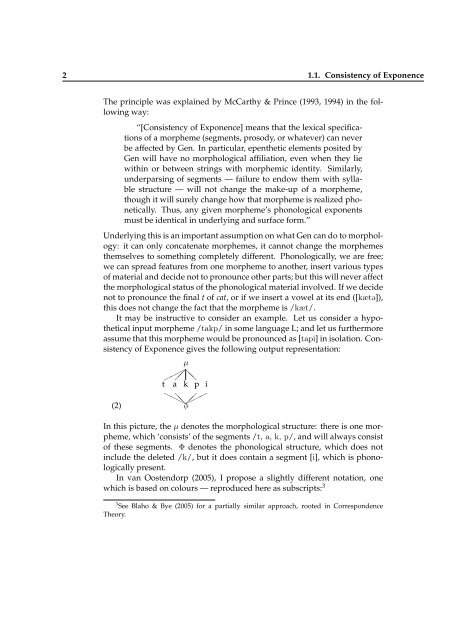Derived Environment Effects and Consistency of ... - Linguistics
Derived Environment Effects and Consistency of ... - Linguistics
Derived Environment Effects and Consistency of ... - Linguistics
Create successful ePaper yourself
Turn your PDF publications into a flip-book with our unique Google optimized e-Paper software.
2 1.1. <strong>Consistency</strong> <strong>of</strong> Exponence<br />
The principle was explained by McCarthy & Prince (1993, 1994) in the following<br />
way:<br />
“[<strong>Consistency</strong> <strong>of</strong> Exponence] means that the lexical specifications<br />
<strong>of</strong> a morpheme (segments, prosody, or whatever) can never<br />
be affected by Gen. In particular, epenthetic elements posited by<br />
Gen will have no morphological affiliation, even when they lie<br />
within or between strings with morphemic identity. Similarly,<br />
underparsing <strong>of</strong> segments — failure to endow them with syllable<br />
structure — will not change the make-up <strong>of</strong> a morpheme,<br />
though it will surely change how that morpheme is realized phonetically.<br />
Thus, any given morpheme’s phonological exponents<br />
must be identical in underlying <strong>and</strong> surface form.”<br />
Underlying this is an important assumption on what Gen can do to morphology:<br />
it can only concatenate morphemes, it cannot change the morphemes<br />
themselves to something completely different. Phonologically, we are free;<br />
we can spread features from one morpheme to another, insert various types<br />
<strong>of</strong> material <strong>and</strong> decide not to pronounce other parts; but this will never affect<br />
the morphological status <strong>of</strong> the phonological material involved. If we decide<br />
not to pronounce the final t <strong>of</strong> cat, or if we insert a vowel at its end ([kæt@]),<br />
this does not change the fact that the morpheme is /kæt/.<br />
It may be instructive to consider an example. Let us consider a hypothetical<br />
input morpheme /takp/ in some language L; <strong>and</strong> let us furthermore<br />
assume that this morpheme would be pronounced as [tapi] in isolation. <strong>Consistency</strong><br />
<strong>of</strong> Exponence gives the following output representation:<br />
(2)<br />
µ<br />
✟<br />
✟<br />
✟ ❅ t a k p i<br />
✟ ✟✟<br />
❍<br />
❍❅<br />
❍❅<br />
<br />
<br />
φ<br />
In this picture, the µ denotes the morphological structure: there is one morpheme,<br />
which ‘consists’ <strong>of</strong> the segments /t, a, k, p/, <strong>and</strong> will always consist<br />
<strong>of</strong> these segments. Φ denotes the phonological structure, which does not<br />
include the deleted /k/, but it does contain a segment [i], which is phonologically<br />
present.<br />
In van Oostendorp (2005), I propose a slightly different notation, one<br />
which is based on colours — reproduced here as subscripts: 3<br />
Theory.<br />
3 See Blaho & Bye (2005) for a partially similar approach, rooted in Correspondence

















